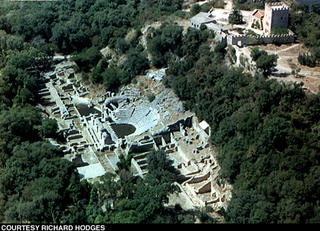A Proper Role for Multinational Forces -- Butrint, Albania
BUTRINT, Albania -- More than 2,000 years after Julius Caesar came here for provisions and decided to start a veterans colony, a new army has invaded -- a multinational force of archaeologists in what is perhaps the largest ongoing dig in the Mediterranean.
Led by Professor Richard Hodges of the University of East Anglia in England, 100 archaeologists from 19 nations, 60 Albanian undergraduates and dozens of local laborers are rotating in over the course of this summer's two-month digging season.
The scientific goal of this decade-long project is to learn how society was transformed at the end of the classical period of ancient Greece and Rome, but the city of Butrint is as much of an attraction. Over the course of 3,000 years, successive civilizations made this city their own. "It became a place in the middle of the Mediterranean where everybody came," Hodges said. ...
The city and the national park that surround it have been designated as a UNESCO World Heritage Site.
Unlike many archaeological sites, the wide-open hinterland and unspoiled surroundings give it another dimension, said Ani Tare, director of Butrint National Park: "Butrint is a magical place, very beautiful. There is something very raw, I would say. It takes you back to time."
That timeless quality and a growing national pride of place are also putting Butrint on the tourism map.
David Chanatry "Archaeologists Peel Away More Layers of Butrint" Washington Post July 18, 2005

Photo credit: Richard Hodges
Led by Professor Richard Hodges of the University of East Anglia in England, 100 archaeologists from 19 nations, 60 Albanian undergraduates and dozens of local laborers are rotating in over the course of this summer's two-month digging season.
The scientific goal of this decade-long project is to learn how society was transformed at the end of the classical period of ancient Greece and Rome, but the city of Butrint is as much of an attraction. Over the course of 3,000 years, successive civilizations made this city their own. "It became a place in the middle of the Mediterranean where everybody came," Hodges said. ...
The city and the national park that surround it have been designated as a UNESCO World Heritage Site.
Unlike many archaeological sites, the wide-open hinterland and unspoiled surroundings give it another dimension, said Ani Tare, director of Butrint National Park: "Butrint is a magical place, very beautiful. There is something very raw, I would say. It takes you back to time."
That timeless quality and a growing national pride of place are also putting Butrint on the tourism map.
David Chanatry "Archaeologists Peel Away More Layers of Butrint" Washington Post July 18, 2005

Photo credit: Richard Hodges


0 Comments:
Post a Comment
<< Home